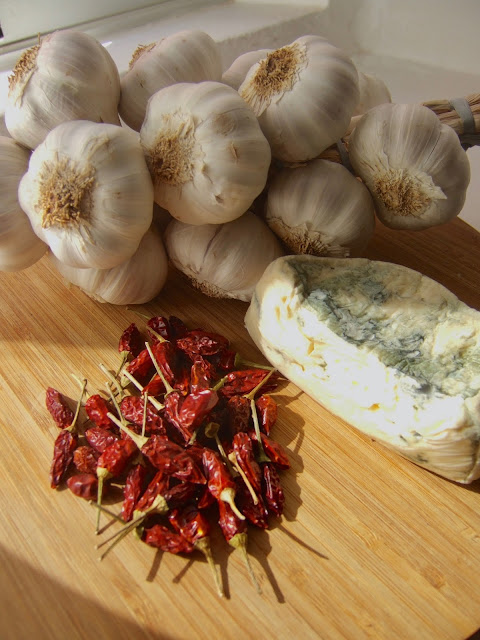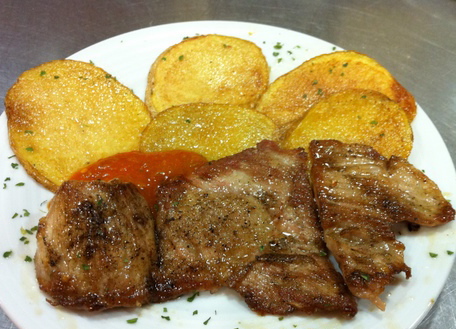From pan to plate,food ethics are back with a vengeance
From field to fork, from salt pan to salt cellar, from coop to casserole,from vine to verjus,most of our food travels a long journey before it gets to our plate. After centuries of neglect, food ethics are back with a vengeance.
From farm and packing shed to wholesale distributor, to warehouse, cardboard cartons can
take a tumble and dent, rendering the contents unsaleable. One traffic
jam too many and pre-washed lettuce can wilt in the plastic bag. How long can food sustain its optimum freshness? I have no intention of buying fine green beans that have been grown in Kenya and then travelled half way round the world encountering many rest stops for packaging and such like before they reach the food hall of Marks and Spencer.That don´t impress me much.
The advantage of living in a small village or the countryside is the ease with which one can source fresh food daily.Our local supermarket here in the village has its own farm just 2 kilometers away and therefore its is only a matter of minutes before fresh produce is on the counter for us to make our selection.On rare occasions I have bought farm fresh free range eggs in the market still warm in the tin bucket from which they were collected.Food cant get much fresher than that.
 This last weekend I happened upon several markets, some artesan but all offering many varieties of food and produce.Many stalls serving delicious home made cakes and pastries.There was an abundance of organically certified growers.Algarvespice, from whom I buy the majority of my spices, had packaged dried Kaffir lime leaves from their own garden as the import channels had seemingly dried up due to the political situations in the native countries of this plants origins.It is so satisfying and rewarding to be able to converse with the person who has actually grown or dried or baked the produce you are buying. On Saturday I came home laden with organic Roma tomatoes, a bunch of garlic heads, an organic home made Roquefort style cheese with red fruits,Rose hip tea, home grown butternut squash and Algarvian avocados.Take for example our local Flor de sal production.
This last weekend I happened upon several markets, some artesan but all offering many varieties of food and produce.Many stalls serving delicious home made cakes and pastries.There was an abundance of organically certified growers.Algarvespice, from whom I buy the majority of my spices, had packaged dried Kaffir lime leaves from their own garden as the import channels had seemingly dried up due to the political situations in the native countries of this plants origins.It is so satisfying and rewarding to be able to converse with the person who has actually grown or dried or baked the produce you are buying. On Saturday I came home laden with organic Roma tomatoes, a bunch of garlic heads, an organic home made Roquefort style cheese with red fruits,Rose hip tea, home grown butternut squash and Algarvian avocados.Take for example our local Flor de sal production.
Instead of heavy machinery, all the work is done by hand, using wooden rakes and shovels. And that’s where the difference between salt and salt lies.
Normal table salt is harvested by machines, and afterwards heated and cleaned, sometimes with the help of chemicals. In this industrialised process, nearly all minerals are lost. When harvesting the salt by hand, there’s no need to clean it afterwards as you can be more precise, and thus the salt retains all the good minerals.Dried in the sun a few metres from our house and ready to travel from salt pan to salt cellar without any middle man.I leave you with the following tip.......
Why would heating salt in a pan prevent food from sticking?
Rub a pancake griddle with a small bag of salt to prevent sticking and smoking. Sprinkle a little salt in the skillet before frying fish to prevent the fish from sticking. Sprinkle salt on washed skillets, waffle iron plates or griddles, heat in a warm oven, dust off salt; when they are next used, foods will not stick.
Most of the described method will help you to clean and dry your pan. A clean pan, especially when it is cast iron, is a happy pan and will work better. A clean and smooth surface, and rubbing salt on it will clean and smooth a metal surface, will also help to prevent food from sticking.
The advantage of living in a small village or the countryside is the ease with which one can source fresh food daily.Our local supermarket here in the village has its own farm just 2 kilometers away and therefore its is only a matter of minutes before fresh produce is on the counter for us to make our selection.On rare occasions I have bought farm fresh free range eggs in the market still warm in the tin bucket from which they were collected.Food cant get much fresher than that.
 This last weekend I happened upon several markets, some artesan but all offering many varieties of food and produce.Many stalls serving delicious home made cakes and pastries.There was an abundance of organically certified growers.Algarvespice, from whom I buy the majority of my spices, had packaged dried Kaffir lime leaves from their own garden as the import channels had seemingly dried up due to the political situations in the native countries of this plants origins.It is so satisfying and rewarding to be able to converse with the person who has actually grown or dried or baked the produce you are buying. On Saturday I came home laden with organic Roma tomatoes, a bunch of garlic heads, an organic home made Roquefort style cheese with red fruits,Rose hip tea, home grown butternut squash and Algarvian avocados.Take for example our local Flor de sal production.
This last weekend I happened upon several markets, some artesan but all offering many varieties of food and produce.Many stalls serving delicious home made cakes and pastries.There was an abundance of organically certified growers.Algarvespice, from whom I buy the majority of my spices, had packaged dried Kaffir lime leaves from their own garden as the import channels had seemingly dried up due to the political situations in the native countries of this plants origins.It is so satisfying and rewarding to be able to converse with the person who has actually grown or dried or baked the produce you are buying. On Saturday I came home laden with organic Roma tomatoes, a bunch of garlic heads, an organic home made Roquefort style cheese with red fruits,Rose hip tea, home grown butternut squash and Algarvian avocados.Take for example our local Flor de sal production.Instead of heavy machinery, all the work is done by hand, using wooden rakes and shovels. And that’s where the difference between salt and salt lies.
Normal table salt is harvested by machines, and afterwards heated and cleaned, sometimes with the help of chemicals. In this industrialised process, nearly all minerals are lost. When harvesting the salt by hand, there’s no need to clean it afterwards as you can be more precise, and thus the salt retains all the good minerals.Dried in the sun a few metres from our house and ready to travel from salt pan to salt cellar without any middle man.I leave you with the following tip.......
Why would heating salt in a pan prevent food from sticking?
Rub a pancake griddle with a small bag of salt to prevent sticking and smoking. Sprinkle a little salt in the skillet before frying fish to prevent the fish from sticking. Sprinkle salt on washed skillets, waffle iron plates or griddles, heat in a warm oven, dust off salt; when they are next used, foods will not stick.
Most of the described method will help you to clean and dry your pan. A clean pan, especially when it is cast iron, is a happy pan and will work better. A clean and smooth surface, and rubbing salt on it will clean and smooth a metal surface, will also help to prevent food from sticking.




Comments
Post a Comment